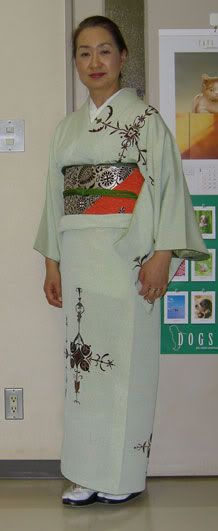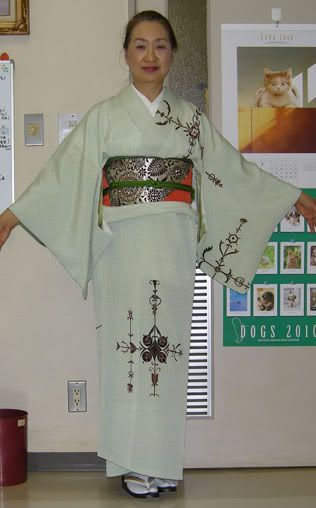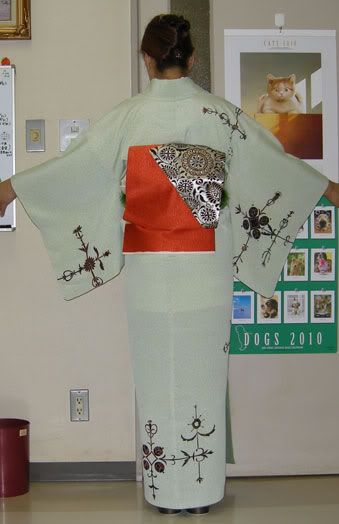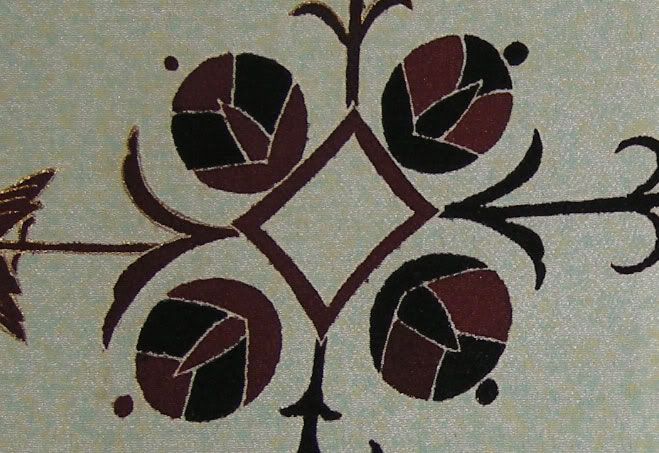Want to buy or sell something? Check the classifieds
-
The Fedora Lounge is supported in part by commission earning affiliate links sitewide. Please support us by using them. You may learn more here.
You are using an out of date browser. It may not display this or other websites correctly.
You should upgrade or use an alternative browser.
You should upgrade or use an alternative browser.
Vintage Kimonos
- Thread starter LaMedicine
- Start date
LaMedicine
One Too Many
- Messages
- 1,116
@ boushi mania
Find a wasai 和裁 tailor. (The lady who fixed your peacoat may know someone.) They can resize the kimonos for you. Kimonos are much much easier to resize than western clothes, because they are sewn with minimum cutting and the *pattern* is the same for all kimonos, the seams all straight lines. If it's too large, then it can be taken in easily, and if too small, then the seams should be checked for allowance, and if there's enough, then they can be let out. This is what I had done to my mother's kimonos, since she is shorter than me by about 8cm, and very slim.
Basically, kimonos aren't sold off the rack, we choose the fabric, then the store will take one's measurements and send it off to the tailor to be sewn. Which means, you don't wait to come across a kimono that fits you, you have it fixed to fit you.
Incidentally, silk kimonos need to be sewn by hand as sewing machines pull too hard on the fabric, but wool and cotton kimonos can be sewn with sewing machines.
Find a wasai 和裁 tailor. (The lady who fixed your peacoat may know someone.) They can resize the kimonos for you. Kimonos are much much easier to resize than western clothes, because they are sewn with minimum cutting and the *pattern* is the same for all kimonos, the seams all straight lines. If it's too large, then it can be taken in easily, and if too small, then the seams should be checked for allowance, and if there's enough, then they can be let out. This is what I had done to my mother's kimonos, since she is shorter than me by about 8cm, and very slim.
Basically, kimonos aren't sold off the rack, we choose the fabric, then the store will take one's measurements and send it off to the tailor to be sewn. Which means, you don't wait to come across a kimono that fits you, you have it fixed to fit you.
Incidentally, silk kimonos need to be sewn by hand as sewing machines pull too hard on the fabric, but wool and cotton kimonos can be sewn with sewing machines.
LaMedicine
One Too Many
- Messages
- 1,116
In my mother's rejuvenated kimono
I posted these pics in the What are you wearing today thread, but anyway.
This was my mother's, the base color light blue, but it had some serious stains all over when she gave it to me. I took it to a kimono craftsman who works with old kimonos. He suggested to redye the kimono by
1) covering the motif with a protective film layer,
2) then use a spray dye method and
3) spray dye first, yellow a shade deeper than the stains, then
4) spray dye light blue a shade deeper than the orginal very light blue base color.
The closeup of the result.

Dig the Art Deco motif of both the kimono and the obi

Showing off the front and back.


The motifs are hand illustrated by Yuzen method.
Proof that is is hand drawn Yuzen are the borderlines between the colors. The line is the result of a special glue that is used to prevent the colors from bleeding into each other. The glue is washed off after the dye dries. Sometimes, these borderlines are left as is, other times, they are filled in with gold, as can be seen in this close up. They may be embroidered as well.
Both blank and gold filled borderlines can be seen.

I posted these pics in the What are you wearing today thread, but anyway.
This was my mother's, the base color light blue, but it had some serious stains all over when she gave it to me. I took it to a kimono craftsman who works with old kimonos. He suggested to redye the kimono by
1) covering the motif with a protective film layer,
2) then use a spray dye method and
3) spray dye first, yellow a shade deeper than the stains, then
4) spray dye light blue a shade deeper than the orginal very light blue base color.
The closeup of the result.

Dig the Art Deco motif of both the kimono and the obi

Showing off the front and back.


The motifs are hand illustrated by Yuzen method.
Proof that is is hand drawn Yuzen are the borderlines between the colors. The line is the result of a special glue that is used to prevent the colors from bleeding into each other. The glue is washed off after the dye dries. Sometimes, these borderlines are left as is, other times, they are filled in with gold, as can be seen in this close up. They may be embroidered as well.
Both blank and gold filled borderlines can be seen.

Featured products
-
 Gustin Vintage Heavyweight Sweatshirt - Natural Rainbow Nep - $119 Rugged 14oz cotton that gets better with every wear.
Gustin Vintage Heavyweight Sweatshirt - Natural Rainbow Nep - $119 Rugged 14oz cotton that gets better with every wear. -
 Grant Stone Diesel Boot Dark Olive Chromexcel - #395 Goodyear welted, Horween Chromexcel, classic good looks.
Grant Stone Diesel Boot Dark Olive Chromexcel - #395 Goodyear welted, Horween Chromexcel, classic good looks. -
 Himel Bros. - The Ross Mk. 1 Leather Jacket Classic D-pocket motorcycle/aviator style jacket.
Himel Bros. - The Ross Mk. 1 Leather Jacket Classic D-pocket motorcycle/aviator style jacket.
LaMedicine
One Too Many
- Messages
- 1,116
Ancient kimono color combinations
A thread on clothes color combinations in the Powder Room reminded me.
There is a very specific series of color combinations for kimonos--less for the kosode types that is the direct ancestor of present day kimono, but for the very traditional Heian era (10-12C) costume, generally called kuge shozoku or nyobo shozoku --called Kasane no Irome, meaning colors of layers. The color combinations were given names of flowers and plants, and which combo should be worn in which season, was strictly defined, with wearing color combos not in season being considered unsophisticated and not in good taste. If any of you have ever studied classic Japanese literature, and are familiar with The Tale of Genji, then you would have read discriptions of choosing and arranging costumes to present to the ladies, giving consideration to the appropriate color combination.
When coordinating kimonos and all the accessories they entail, if we are at a loss with what colors to coordinate, we are often told to use these traditional combination as points of reference.
There are two groups of Kasane, the first being two or three colors layered one over another. Since the fabrics were light silk, the color of the inner layer shadows the top layer resulting in subtle nuances.
The second group was for the nyobo shozoku, the most formal known as junihitoe, twelve layers. With this costume, rather than the outer color being influenced by the inner color, the effect was to have tasteful color gradation on the open end of the layered sleeves and the hemline.
The following links to a page of kasane colors of the first group. The colors on the right within the frame is the top color, the left the inner color, and the middle, the resulting effect. Sorry the text is in Japanese, but I'm sure you'll enjoy the colors.
Kasane no Irome (1)
Kasane no Irome (2) (scroll down)
The following links to the second group of kasane colors.
The color on the right is the topmost layer, and grades down to the left to the color of the innermost garment.
Kasane no Irome (3)
Kasane no Irome (4) (scroll down a bit)
A thread on clothes color combinations in the Powder Room reminded me.
There is a very specific series of color combinations for kimonos--less for the kosode types that is the direct ancestor of present day kimono, but for the very traditional Heian era (10-12C) costume, generally called kuge shozoku or nyobo shozoku --called Kasane no Irome, meaning colors of layers. The color combinations were given names of flowers and plants, and which combo should be worn in which season, was strictly defined, with wearing color combos not in season being considered unsophisticated and not in good taste. If any of you have ever studied classic Japanese literature, and are familiar with The Tale of Genji, then you would have read discriptions of choosing and arranging costumes to present to the ladies, giving consideration to the appropriate color combination.
When coordinating kimonos and all the accessories they entail, if we are at a loss with what colors to coordinate, we are often told to use these traditional combination as points of reference.
There are two groups of Kasane, the first being two or three colors layered one over another. Since the fabrics were light silk, the color of the inner layer shadows the top layer resulting in subtle nuances.
The second group was for the nyobo shozoku, the most formal known as junihitoe, twelve layers. With this costume, rather than the outer color being influenced by the inner color, the effect was to have tasteful color gradation on the open end of the layered sleeves and the hemline.
The following links to a page of kasane colors of the first group. The colors on the right within the frame is the top color, the left the inner color, and the middle, the resulting effect. Sorry the text is in Japanese, but I'm sure you'll enjoy the colors.
Kasane no Irome (1)
Kasane no Irome (2) (scroll down)
The following links to the second group of kasane colors.
The color on the right is the topmost layer, and grades down to the left to the color of the innermost garment.
Kasane no Irome (3)
Kasane no Irome (4) (scroll down a bit)
Similar threads
- Replies
- 5
- Views
- 3K
- Replies
- 1
- Views
- 1K
- Replies
- 3
- Views
- 8K
- Replies
- 1
- Views
- 12K